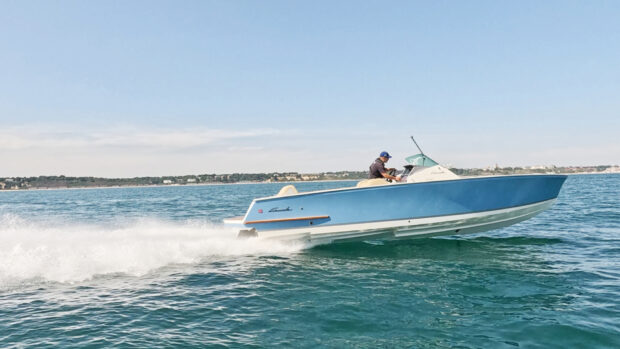Crew are a great help to have on a boat but being able to use your vessel single-handed also has its advantages. Jon Mendez explains all in our latest video on how to drive a boat...
It’s especially useful when teaching new crew what to do as they can watch the first time, help out the second time and do it all themselves from then on.
Driving a boat solo also has some important safety considerations as it makes you realise what can be accomplished alone and what is just too difficult or dangerous.
Leaving an alongside berth single-handed on a 60ft craft takes planning and requires using the boat’s controls and the prevailing conditions to your advantage.
The boat we’re using has twin shafts and a bow thruster, and we are starboard side-to with a gentle breeze holding us on, there is also an ebb tide on the stern. The first step is always to work out what will happen and how.
If I undid all the lines at once, initially the boat wouldn’t move with the wind but as the ebb tide edged it forward along the berth, the breeze would then pivot us around the end of the pontoon, and both the wind and the tide would continue to push it across onto the other boats.
Article continues below…

How to drive a boat: Turning an outboard-engined boat in a tight space

How to drive a boat in rough water: Big sea throttle techniques explained
So, with the dangers established – the corner of our own berth and the boats opposite – how should we leave? Before you do anything first check that the engines are running, the gears engage and the bow thruster is working.
Next take the springs off so that there is only a bow and a stern line holding you in place. A quick glance should confirm that the bow line is reasonably slack, while the stern line is taut from the ebb flow.
Also check that the boat fenders are correctly positioned as you will need to move the bow away from the pontoon, which will push the stern in towards the pontoon.
Once satisfied, remove the bow line first and lay it along the side deck as you walk back toward the stern in case you need to put it back on at short notice.
With this sorted, prepare to remove the stern line. I like to pull the taut part of the line slightly to reduce the tension before starting to undo and coil the excess line from the cleat.
Now release the last loop which is securing the boat either from the boat itself or the pontoon and step onboard making your way swiftly to the controls.
Next check that the boat hasn’t already started moving along the pontoon, if it has a small click of the pontoon side engine astern will stop that movement and bring the stern slightly away.
Next use the bow thruster for long enough to push the bow well away from the pontoon. This also pushes the stern closer, so to prevent it getting too close you will need to use the outside engine ahead. This will pivot the boat and move the stern clear.
As the boat comes clear and roughly parallel to the pontoon either use both engines ahead for half a second to gain some momentum or alternatively each engine in turn to walk the boat out of the berth. I generally keep the helm straight ahead for this movement.
The next key point is to stop the boat mid-aisle so that you don’t turn with any momentum and get swept onto the boats opposite. In this instance we need to turn to starboard to leave so either both engines astern to stop or just starboard astern so that you are not only slowing but starting the turn for your exit.
I like to use a transit to my side to check that I am turning on the spot with no down element drift. The turn can be accomplished either by using one engine at a time or one ahead and one astern to make the turn more positive.
I use the helm for the turn on the ahead engine. Always aim slightly up-element as you finish the turn so that you are heading towards the safe side for your exit.
If you enjoyed this…
Be first to all the latest boats, gadgets, cruising ideas, buying advice and readers’ adventures with a subscription to Motor Boat & Yachting. Available in both print and digital formats, our monthly magazine will be sent directly to your home or device at a substantial discount to the usual cover price. See our latest offers and save at least 30% off the cover price.










